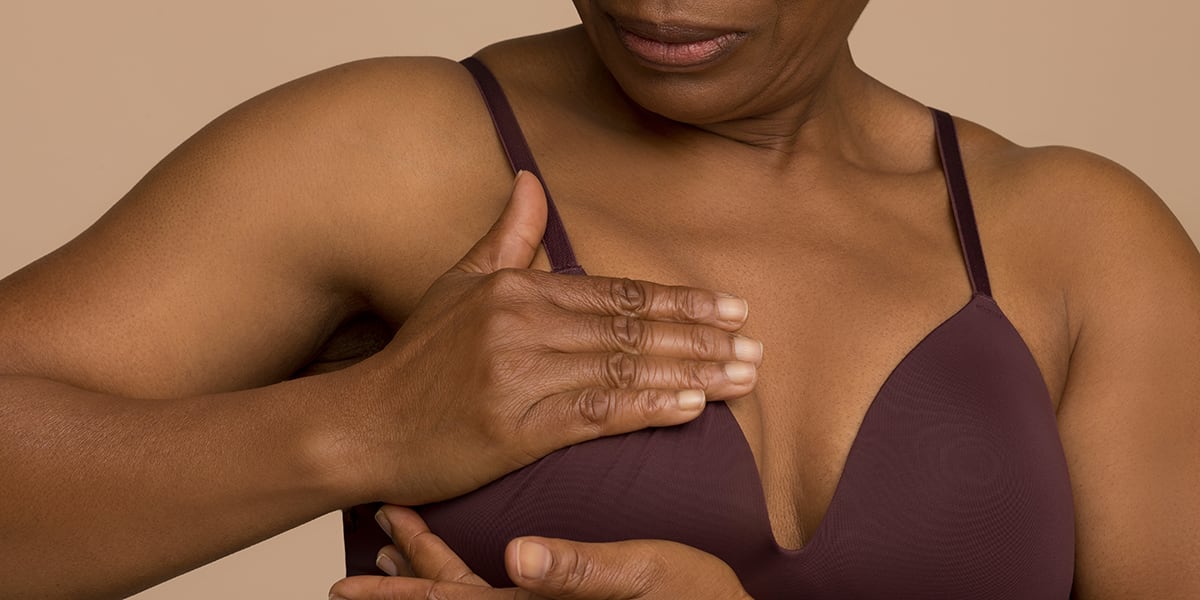Expert review by Rupa Dainer
Published: 20. May 2024

Breast cancer changes breast tissue as it develops and progresses. Some of these changes are subtle so it’s important to pay attention to your breasts and to know what’s normal for you. Recognizing a change or symptom quickly can help with early detection and ensure you get treated as quickly as possible. In the long run, this can really improve your clinical outcomes.
Let’s run through the main signs of breast cancer and why early detection is so important. By the end of this article, you’ll be more informed about the symptoms of breast cancer and self-screening techniques, and feel empowered to actively monitor the health of your breasts.
You’ll learn about:
- Various breast cancer symptoms and how to recognize them
- Why early detection is so important
- Why you need to consult your healthcare provider
What are breast cancer symptoms?
Early detection of breast cancer is key, consequently, familiarity with subtle symptoms is invaluable and potentially life-saving. Breast cancer symptoms range from visible changes in the appearance of the breast, to subtle internal changes that are better felt rather than seen.
Along with this diversity in manifestation is a spectrum in awareness. While some symptoms may be more commonly known, such as a lump in the breast tissue, others like changes in skin texture or a persistent rash are less familiar and can be easily overlooked.
Early symptoms of breast cancer
In the initial stages, breast cancer symptoms – can be subtle and often include:
- A new lump or mass in the breast or underarm
- Partial or widespread swelling of the breast, even in the absence of a distinct lump
- Skin irritation or dimpling
- Breast or nipple pain
- Nipple retraction (turning inward)
- Redness, scaliness, or thickening of the nipple or breast skin
- Nipple discharge (other than breast milk).
It’s important to note that these symptoms can also be associated with various benign breast conditions; non-cancerous disorders that can affect the breasts.
Conditions falling under the non-cancerous category are, for example: fibrocystic changes, cysts, intraductal papillomas, mastitis, or breast calcifications. These benign conditions are relatively common and may have symptoms similar to those of breast cancer. This is why self-education and cooperation with a trusted healthcare provider is crucial.
Benign and malignant breast cancer symptoms – what’s the difference?
It’s important to distinguish between normal breast changes and potential signs and symptoms of breast cancer. Common signs of non-cancerous breast conditions include symptoms that change over the course of the menstrual cycle, such as breast tenderness or lumpiness. Additionally, symptoms which appear in both breasts or multiple areas are more likely to be benign.
Also worth noting, non-cancerous lumps are typically smooth, and round to the touch, and may be slightly mobile when pressed.
Some important symptoms that could cause concern include:
- New lumps
- Changes on a single breast
- Dimpling or puckering of skin (like an orange peel)
- Nipple or skin reaction
- Persistent pain
- Redness or heat
- Swelling of part of the breast
- Lymph node change.
Regardless of whether symptoms are mild or are causing active distress, patients should always consult a doctor to determine the cause of any changes they experience.
Symptoms of specific breast cancer types
While certain symptoms like lumps and changes in breast texture are nearly universal across cases, breast cancer can also manifest in type-specific ways. From the rash-like appearance associated with inflammatory breast cancer to the unique challenges of identifying symptoms in male breast cancer, understanding these distinctive changes is key to a timely and accurate diagnosis.
Inflammatory breast cancer symptoms
Inflammatory breast cancer is a rare and aggressive form of the disease that progresses quickly, often without the formation of a distinct lump. The rapid course of disease may lead to it being mistaken for signs of infection or other non-cancerous conditions. Key symptoms of inflammatory breast cancer include:
- Persistent redness and swelling
- Thickened skin texture
- Rapid changes
- Tenderness and pain
- Inverted nipple
- Swollen lymph nodes
Due to its rapid coursen, it’s crucial to have any potential symptoms of inflammatory breast cancer assessed by a healthcare professional as soon as possible for the best possible outcome.
Metastatic and advanced breast cancer symptoms
As breast cancer spreads beyond the breast to other parts of the body entering the metastatic stage, symptoms become more complex and diffuse. The signs of metastatic breast cancer can vary greatly depending on the extent of disease and the location to which the cancer has spread. These symptoms could involve:
- Bone pain and fractures: If cancer spreads to the bones, it can cause persistent pain, brittleness, and an increased risk of fractures.
- Neurological symptoms: Metastasis in the brain might lead to headaches, dizziness, or even seizures.
- Breathing difficulties: Cancer that has spread to the lungs can result in shortness of breath or a chronic cough.
- Abdominal pain and jaundice: Liver metastasis can cause abdominal pain, jaundice (yellowing of the skin and eyes), or changes in liver function tests.
- Lymphedema: Swelling in the arms or legs due to lymph node involvement can occur, sometimes causing discomfort or reduced mobility.
These symptoms highlight the severity of advanced breast cancer and emphasize the need for ongoing monitoring and adjustments to the treatment. It is crucial for patients with advanced breast cancer to stay in close contact with their healthcare team to manage symptoms effectively and improve their quality of life.
Triple-negative breast cancer symptoms
Triple-negative breast cancer is a notably aggressive form of the disease. It is called ‘triple-negative’ because estrogen and progesterone receptors are not the primary drivers of progression nor do the tumors overexpress the HER2 protein.
This makes it resistant to some common breast cancer treatments which center on hormonal therapy or directly targeting HER2. While the symptoms of triple-negative breast cancer are similar to those of other types, it’s crucial to be extra vigilant due to its rapid progression and aggressive nature.
Symptoms of Triple Negative Breast Cancer may include:
- Rapidly growing lumps: A lump that appears suddenly and grows rapidly may be a sign of triple-negative breast cancer.
- Changes in shape or size of breast: Noticeable alterations in the shape, size, or symmetry of the breasts that develop swiftly.
- Textural changes of the skin: The skin on the breast may become thickened or take on an unusual texture, sometimes accompanied by visible veins.
Due to its aggressive behavior and limited treatment options, it is crucial for individuals with noticeable symptoms of triple-negative breast cancer to seek specialized medical attention immediately as early detection and a tailored treatment plan are essential for management.
Male breast cancer symptoms
While less common, male breast cancer symptoms and risk factors mirror those in females. Early-stage male breast cancer symptoms can be identified through pictures and descriptions, but the most common sign is a lump in the breast.
Breast cancer symptoms that are often overlooked
Certain symptoms of breast cancer, regardless of the type, can be subtle and easily overlooked, yet they play a crucial role in early detection. In the case of inflammatory breast cancer for example, skin changes such as redness, warmth, and an orange-peel texture, known as “peau d’orange” represent a key diagnostic feature
It is important to be able to recognize these symptoms, as they often signify more advanced or aggressive subtypes. Other commonly missed symptoms across various types of breast cancer include:
- Subtle swelling in part of the breast, which might alter the breast’s shape or size.
- Unexplained, persistent itching of the breast or nipple area.
- Nipple changes including inversion, discoloration, or unusual discharge not related to breastfeeding.
- Skin texture changes including dimpling, puckering, or thickening of the breast skin.
Recognizing these symptoms is essential as they could indicate an underlying issue that requires medical attention. Regular self-examinations and awareness of these less obvious symptoms can be key in detecting breast cancer in its earlier, more treatable stages.
When to consult a healthcare professional
If you observe any early signs of breast cancer or detect new, persistent changes in your breast, it’s crucial to schedule a visit with a healthcare professional who can conduct the necessary examinations and tests for diagnosis. Keep in mind that seeking medical advice and intervention as soon as possible can greatly impact your prognosis.
In summary
This article outlines various symptoms associated with breast cancer, and highlights the importance of early detection across all types and stages of this disease. Our goal is to empower you with the knowledge needed to identify potential warning signs of breast cancer and encourage proactive health measures.
Remember, early detection can make a significant difference, and seeking medical advice promptly when symptoms arise is a crucial step in your health journey. We urge you to stay informed, stay observant, and prioritize your breast health.

